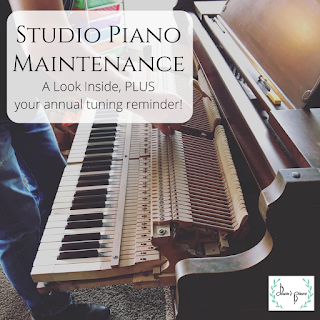Piano Maintenance is a vitally important part of being able to practice, build healthy technique, and to play well. Our studio piano was due for a tuning this summer, and I also asked Chuck Vetter, our technician here in town, to see what he good do about the tone. Our studio piano is pretty old, and it sees a lot of regular use by lots of young, very eager pianists, so the action needed some TLC. I grabbed some photos while he was working because I thought students would enjoy seeing the inner workings of the piano, and here was the result:
 |
| Removing the Action from the piano to work on the voicing. We also took the opportunity to vacuum out the large dust bunnies that inevitably settle in over the years. |
 |
| The cabinet without the action. |
 |
| To improve the tone, Chuck worked on adjusting the felt on the hammers (on the left of this photo) so when they hit the strings they will create a warmer tone instead of a harsher sound. This process is called Voicing the piano. |
 |
| Reassembled and ready to play again. Chuck even replaced our broken key top! |
If your piano kid enjoys seeing the 'how things work' side of the piano, be sure to keep an eye out for our September Piano Party, which will be all about how the piano works. From identifying some of the key components and mechanisms in the instrument, to what happens when we strike a key to make a sound, and what all the pedals do, we'll get an up-close look under the lid!
And if your home practice instrument is due for a tune-up, the beginning of the school year is a great time to schedule that appointment and set your piano kid up for a successful year with the best home practice environment you can provide them. If you want more information about why tuning is so important, you can check out this blog post about the importance of piano tuning.




